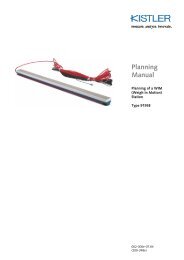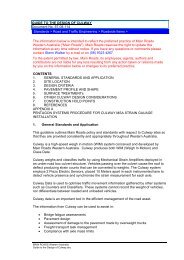Installation of Fixed Capacitive HSWIM Sensors
Installation of Fixed Capacitive HSWIM Sensors
Installation of Fixed Capacitive HSWIM Sensors
Create successful ePaper yourself
Turn your PDF publications into a flip-book with our unique Google optimized e-Paper software.
Note: The frame must be set 2-3mm lower than the surface. In cases where the<br />
pavement is slightly uneven it might be necessary to make a deeper recess than<br />
45m to allow for this. Place the frame in the open hole to check the final depth.<br />
Clean the excavation <strong>of</strong> all the lose material.<br />
Cut in the sensor feeder cable groove. This must be done beforehand to<br />
accommodate the earth wire leading from the frame.<br />
Mask the edges <strong>of</strong> the excavation (Picture 15 on page 41).<br />
6.3 Drilling <strong>of</strong> anchor holes<br />
Diagram 5 illustrates the frames that road anchors hook on. Note the direction <strong>of</strong> the<br />
hook when drilling the hole. The holes are drilled using a 25mm masonry drill bit, at an<br />
angle <strong>of</strong> approximately 45° to the horizontal position. Holes are drilled to a depth <strong>of</strong><br />
200mm to allow for the anchor. Pictures 12 & 17 on page 41 <strong>of</strong> the Picture gallery<br />
(Annexure D) illustrate how these holes are drilled.<br />
Fill the holes with a thin epoxy mixture and release all the trapped air before inserting<br />
the anchor.<br />
40 mm<br />
Road anchor detail<br />
180 mm<br />
Frame detail, arrows indicate direction <strong>of</strong> drill holes<br />
Diagram 5: Road anchor detail<br />
15 mm<br />
MS001-96100-52 <strong>Installation</strong> <strong>of</strong> <strong>Fixed</strong> <strong>Capacitive</strong> <strong>HSWIM</strong> <strong>Sensors</strong> Issue5 1 March 2005<br />
12 / 56
















